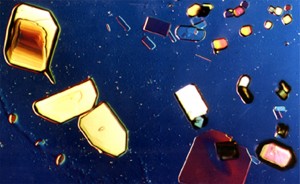This top image is that of table sugar magnified 30x – sweet signals that the food is an energy source, and generally safe to eat. Though not all sweet things are safe. For instance, some lead salts are sort of sweet yet deadly; I presume they would likely have an altered shape. The taste of sweet requires a cellular receptor to take in the information.
On the left  is photomicrographic expression of a sauvignon blanc which was featured in Scientific American’s “Molecules” by PW Atkins to begin the chapter on taste, smell and pain. What do you think this wine would taste like? Buttery, thin, robust, angular?
is photomicrographic expression of a sauvignon blanc which was featured in Scientific American’s “Molecules” by PW Atkins to begin the chapter on taste, smell and pain. What do you think this wine would taste like? Buttery, thin, robust, angular?
Obsessed as I have been for decades about taste and shape, I am always looking for words that convey the mystery of our senses.
Here I’ve adapted the introduction to the chapter, as eloquently written by Dr. Atkins, the book’s author.
“Explore here how molecules can act as messengers between the external world and the internal universe of consciousness within our heads. All neuronal activity depends on the transport of molecules and ions from one location to another and the processes they facilitate.”
Change of place (from here to there) is one action molecules make to initiate change or perception.
Some molecules directly stimulate perception of our surroundings, namely the perception of taste, smell and pain.
Our perception of Taste, Smell and some kinds of pain depend upon direct molecular interaction with signals from our surroundings.
- Our taste sensors are in the tongue
- Smell sensors inhabit the nose
- Certain kinds of pain receptors pervade the skin and organs
This molecule of taste elicits a sweet sensation. Above image is sucrose magnified.
In contrast, check out a molecule that elicits the perception of sour – it must move differently than sweet to trigger its taste. NOTICE the angular and sharp forms created by this molecule. Compare to the soft rounded shapes of sweet.

